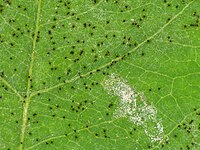
Back Meeldou Afrikaans بياض دقيقي Arabic بياض دقيقى ARZ Oïdi Catalan Милдью CV Melduo Esperanto Oídio Spanish Jahukaste Estonian Zurin Basque سفیدک پودری Persian
| Powdery mildew | |
|---|---|
 Example of powdery mildew (right) along with Downy mildew on a grape leaf | |
| Causal agents | Species of fungi in the order Erysiphales |
| Hosts | plants |
Powdery mildew is a fungal disease that affects a wide range of plants. Powdery mildew diseases are caused by many different species of ascomycete fungi in the order Erysiphales. Powdery mildew is one of the easier plant diseases to identify, as the signs of the causal pathogen are quite distinctive. Infected plants display white powdery spots on the leaves and stems.[1] This mycelial layer may quickly spread to cover all of the leaves. The lower leaves are the most affected, but the mildew can appear on any above-ground part of the plant. As the disease progresses, the spots get larger and denser as large numbers of asexual spores are formed, and the mildew may spread up and down the length of the plant.
Powdery mildew grows well in environments with high humidity and moderate temperatures; greenhouses provide an ideal moist, temperate environment for the spread of the disease. This causes harm to agricultural and horticultural practices where powdery mildew may thrive in a greenhouse setting.[2] In an agricultural or horticultural setting, the pathogen can be controlled using chemical methods, bio-organic methods, and genetic resistance. It is important to be aware of powdery mildew and its management strategies as the resulting disease can significantly reduce important crop yields.[3]



- ^ Ciliberto, Giada (2024-03-31). "Lo chiamano il "mal bianco" ed è una malattia delle piante: come riconoscerla e combatterla". retididedalus.it (in Italian). Retrieved 2024-04-02.
- ^ Keinath, Anthony P.; DuBose, Virginia B. (2012-12-01). "Controlling powdery mildew on cucurbit rootstock seedlings in the greenhouse with fungicides and biofungicides". Crop Protection. 42: 338–344. Bibcode:2012CrPro..42..338K. doi:10.1016/j.cropro.2012.06.009.
- ^ "Powdery Mildew". Small Grain Wheat Diseases. Archived from the original on 2002-12-23.